
If you’ve been wondering how to overcome anxiety daily, the answer lies in small but consistent actions that promote both mental and physical well-being. Anxiety may feel overwhelming, but it’s manageable with the right habits.
Incorporating simple practices like mindful breathing, journaling, or regular exercise into your daily routine can significantly reduce anxiety and help you feel calmer and more balanced.
This article will guide you through 10 trusted and effective strategies to help you overcome anxiety daily and regain control of your life.
Table of Contents
- 1. Begin Your Day with a Morning Walk
- 2. Create a Daily Breathing Ritual
- 3. Try Progressive Muscle Relaxation (PMR)
- 4. Stay Consistent with Balanced Meals
- 5. Commit to 30 Minutes of Exercise Daily
- 6. Practice Mindful Body Scanning
- 7. Journal Your Thoughts Daily
- 8. Get Daily Sunlight Exposure
- 9. Focus on Posture Correction
- 10. Practice Guided Visualization
- Conclusion
1. Begin Your Day with a Morning Walk
Walking outdoors every morning is a simple but powerful way to set the tone for the day. If you’ve been searching for how to overcome anxiety daily, starting with a morning walk allows you to reconnect with nature and find calmness before the day begins. This habit not only improves your mood but also clears your mind, preparing you to handle stress with confidence.
Why it works: Exposure to natural light during a morning walk helps regulate serotonin levels, improving your mood and reducing anxious thoughts.
How to do it:
Dedicate 20-30 minutes every morning to walking outdoors, preferably in a park or quiet area.
Focus on the sounds, sights, and smells around you to practice mindfulness as you walk.
Pair it with deep breathing for an added calming effect.
Motivational Effect: A morning walk sets a positive tone for your day, reminding you that you are taking steps—literally and figuratively—toward a calmer mind.
“Stress and anxiety may try to trap you in a cycle of fear, but remember: every moment is a chance to break free. You are not defined by your struggles; you are defined by the strength you show in facing them. The climb may feel steep, and the path unclear, but every small act of courage—a deep breath, a kind word to yourself, a pause to rest—is progress. Don’t underestimate the power of persistence; what feels heavy today will feel lighter tomorrow. You are capable of turning your stress into fuel for growth.”
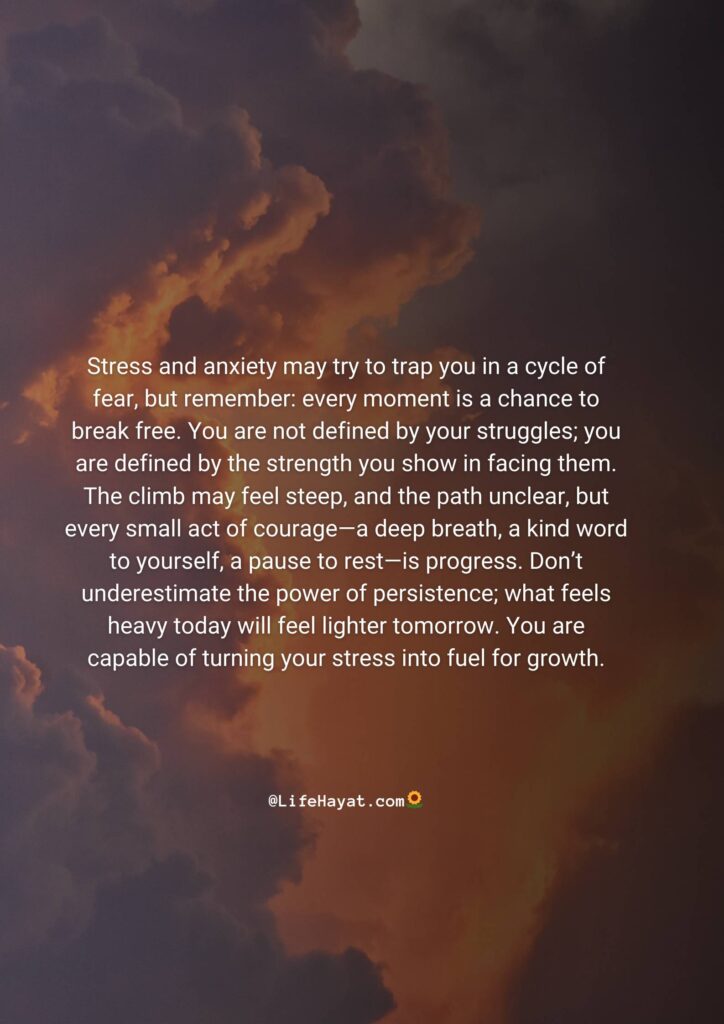
2. Create a Daily Breathing Ritual
Controlled breathing helps regulate your nervous system and reduces the physical symptoms of anxiety, such as a racing heart or shallow breathing.
Why it works: Breathing techniques like the 4-7-8 method activate the parasympathetic nervous system, signaling your body to relax.
How to do it:
- Sit in a quiet place and close your eyes.
- Inhale deeply through your nose for a count of 4.
- Hold your breath for a count of 7.
- Exhale slowly through your mouth for a count of 8.
- Repeat this cycle for 5-7 minutes daily.
Motivational Effect: This practice teaches your body how to respond calmly to stress, empowering you to take control during anxious moments.
3. Try Progressive Muscle Relaxation (PMR)
Progressive Muscle Relaxation is a powerful technique for releasing physical tension and calming the mind.
Why it works: PMR helps you identify areas of tension in your body and consciously release them, reducing both physical and mental stress.
How to do it:
- Lie down or sit comfortably in a quiet space.
- Start with your toes: tense the muscles for 5 seconds, then relax them completely.
- Gradually work your way up your body—calves, thighs, abdomen, chest, arms, and face.
- Pair the process with slow, deep breaths.
Motivational Effect: With each muscle you relax, you’re letting go of stored tension, reminding yourself that you have the power to release anxiety.
“Anxiety is not your enemy; it’s a voice within you, warning you, protecting you—but it doesn’t always tell the truth. When you feel overwhelmed, remind yourself that the storm will pass, and you have the strength to endure. You’ve survived every difficult moment up to now, and you will survive this one too. Each breath you take is proof of your resilience, and each small step forward is a victory over the weight of fear. You are more powerful than your anxious thoughts, and you are capable of finding peace beyond the chaos.”
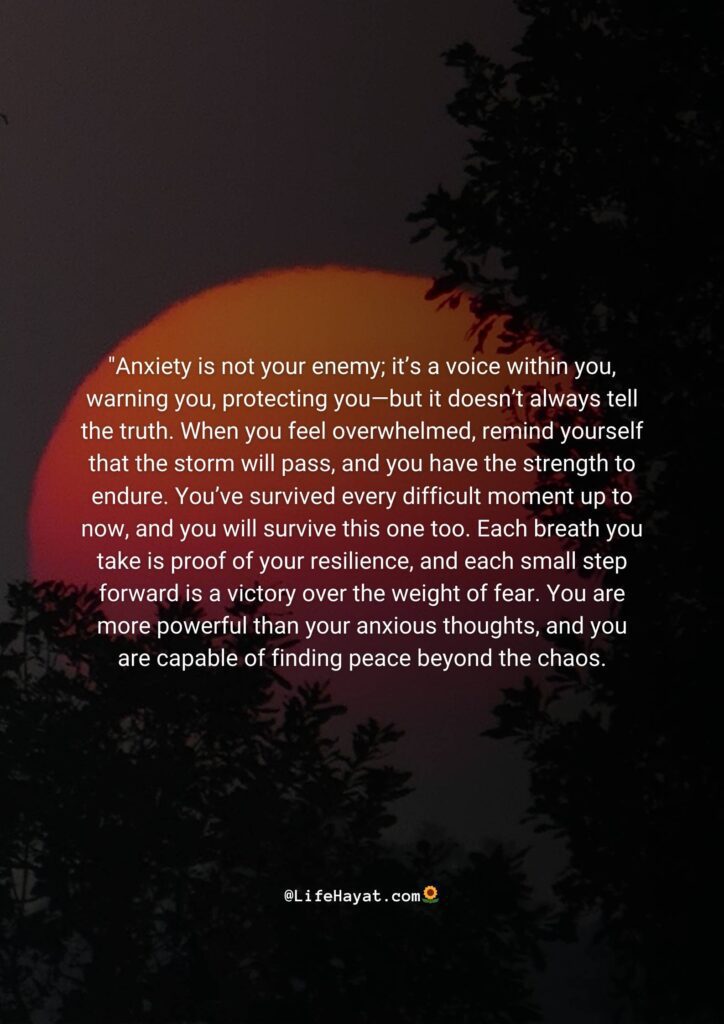
4. Stay Consistent with Balanced Meals
Your body and mind thrive on proper nutrition, and eating well can reduce anxiety symptoms significantly. Learning how to overcome anxiety daily includes fueling your body with the nutrients it needs to stay strong and focused. A consistent diet rich in whole foods will help stabilize your mood and provide the energy you need to tackle challenges.
Why it works: Nutrients like magnesium, omega-3 fatty acids, and complex carbohydrates support brain health and stabilize your mood.
How to do it:
Include foods like spinach, avocados, salmon, and whole grains in your meals.
Avoid skipping meals, as low blood sugar can worsen anxiety symptoms.
Limit processed foods and sugary snacks that cause energy crashes.
Motivational Effect: Each nutritious meal you eat is a step toward physical and mental stability, proving you are taking care of yourself.
5. Commit to 30 Minutes of Exercise Daily
Physical activity is a proven way to reduce anxiety, as it boosts endorphins and decreases stress hormones.
Why it works: Exercise increases blood flow to the brain, improving mood and focus while reducing tension.
How to do it:
Choose an activity you enjoy, such as brisk walking, or cycling.
Aim for at least 30 minutes of moderate exercise daily.
If possible, exercise outdoors to combine the benefits of nature and physical activity.
Motivational Effect: With every workout, you’re building a healthier mind and body, empowering yourself to face challenges with strength.
“Anxiety may whisper that you’re weak, but the truth is, every day you fight it, you prove your strength. Stress might try to knock you down, but it’s also a reminder of your humanity, your passion, your desire to care and succeed. The key isn’t to eliminate all anxiety but to learn to dance with it, to acknowledge its presence without letting it control you. You have the tools within you—your breath, your courage, your determination—to rise above it. Each moment you choose hope over fear, you are rewriting your story.”
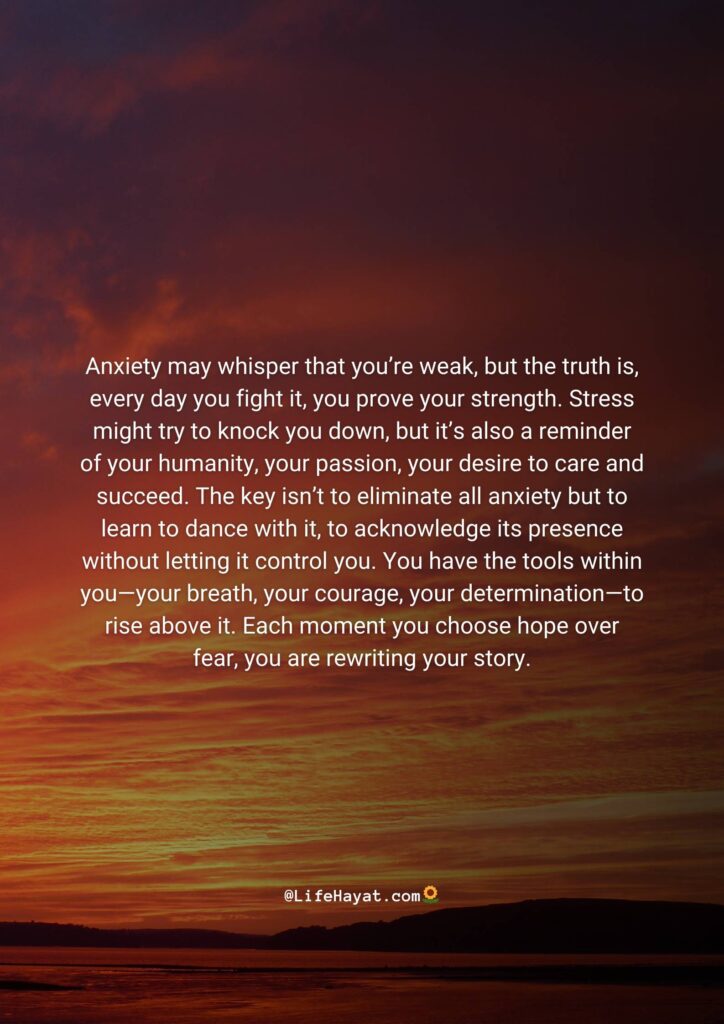
6. Practice Mindful Body Scanning
Mindful body scanning helps you connect with your physical self, release tension, and calm your mind.
Why it works: It increases awareness of your body, allowing you to recognize and release areas of stress.
How to do it:
- Sit or lie down in a quiet space.
- Close your eyes and focus on your toes, noticing any sensations.
- Gradually move your attention upward to your legs, abdomen, chest, arms, neck, and head.
- Consciously relax each muscle group as you go.
Motivational Effect: This practice reminds you to care for your body, teaching you how to let go of stress and reconnect with the present moment.
7. Journal Your Thoughts Daily
Journaling is a therapeutic way to process your emotions and clear your mind.
Why it works: Writing down your worries helps you externalize them, making them feel less overwhelming.
How to do it:
Spend 10-15 minutes daily writing about your thoughts and feelings.
Focus on gratitude by listing 3 things you’re thankful for each day.
Use prompts like “What’s one thing I can let go of today?” to guide your journaling.
Motivational Effect: Journaling helps you take control of your thoughts, transforming worry into clarity and self-awareness.
“Stress is a test, not a sentence. Anxiety may try to tie your mind in knots, but within you lies the power to untangle them, thread by thread. Take a moment to pause, breathe, and remember: this is not the end, but the beginning of something stronger. Every challenge you face is an opportunity to grow, to learn, and to rise. You have survived every hard day before, and you will survive this one too. Trust in your ability to adapt, to persevere, and to reclaim your peace.”
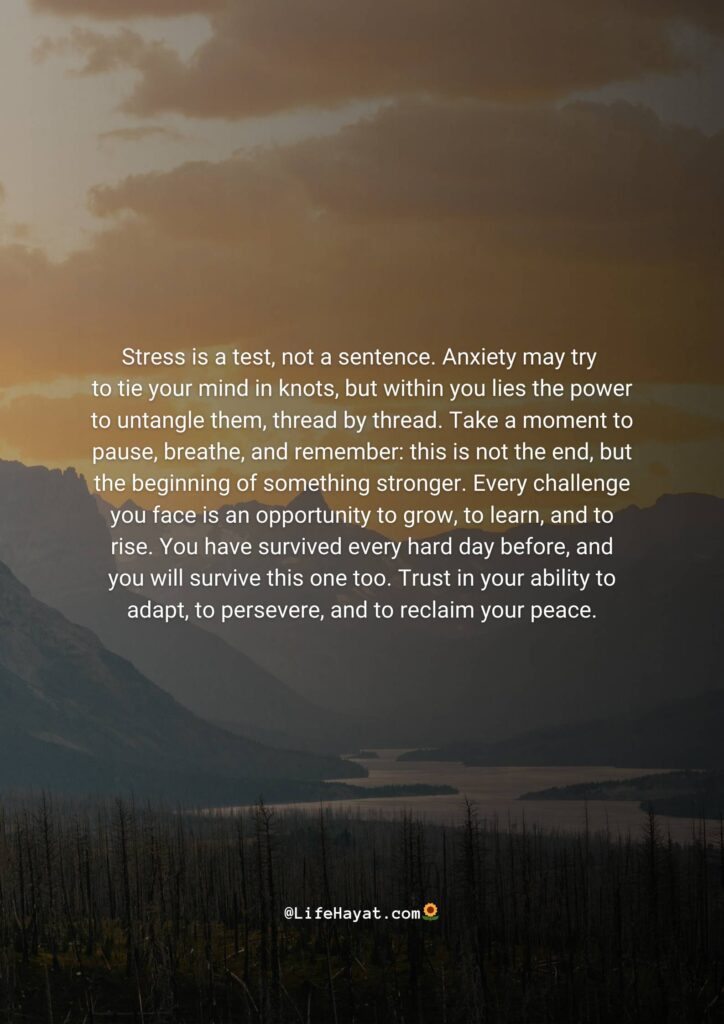
Words Of Gratitude And Appreciation – 30 Inspiring Quotes
8. Get Daily Sunlight Exposure
Sunlight plays a key role in regulating mood by boosting serotonin levels, a natural anxiety-reducing neurotransmitter.
Why it works: Exposure to sunlight improves your body’s production of serotonin and vitamin D, both of which support mental health.
How to do it:
Spend at least 10-15 minutes outdoors in the morning or early afternoon.
Take a walk, sit by a window, or enjoy your coffee on a balcony.
Motivational Effect: Sunlight is nature’s way of recharging your mind, giving you the energy and clarity to tackle the day.
9. Focus on Posture Correction
Poor posture can contribute to feelings of anxiety, while good posture boosts confidence and reduces tension.
Why it works: Sitting or standing upright sends positive signals to your brain, improving mood and reducing physical discomfort.
How to do it:
Sit with your back straight, shoulders relaxed, and chest slightly lifted.
Set reminders to check your posture throughout the day.
Practice posture exercises, like pulling your shoulder blades together for 10 seconds.
Motivational Effect: Maintaining good posture is a simple way to show self-respect and take charge of your mental and physical health.
“Anxiety may make you feel small, but the truth is, it cannot dim your light. The moments when you feel most afraid are the moments when you’re closest to discovering your inner strength. Let stress be your teacher, not your master. It can show you where you need to grow, where you need to heal, and where you need to believe in yourself again. The path to peace is not about perfection but about progress. Take each day step by step, knowing that you are enough, just as you are, and that brighter days are ahead.”
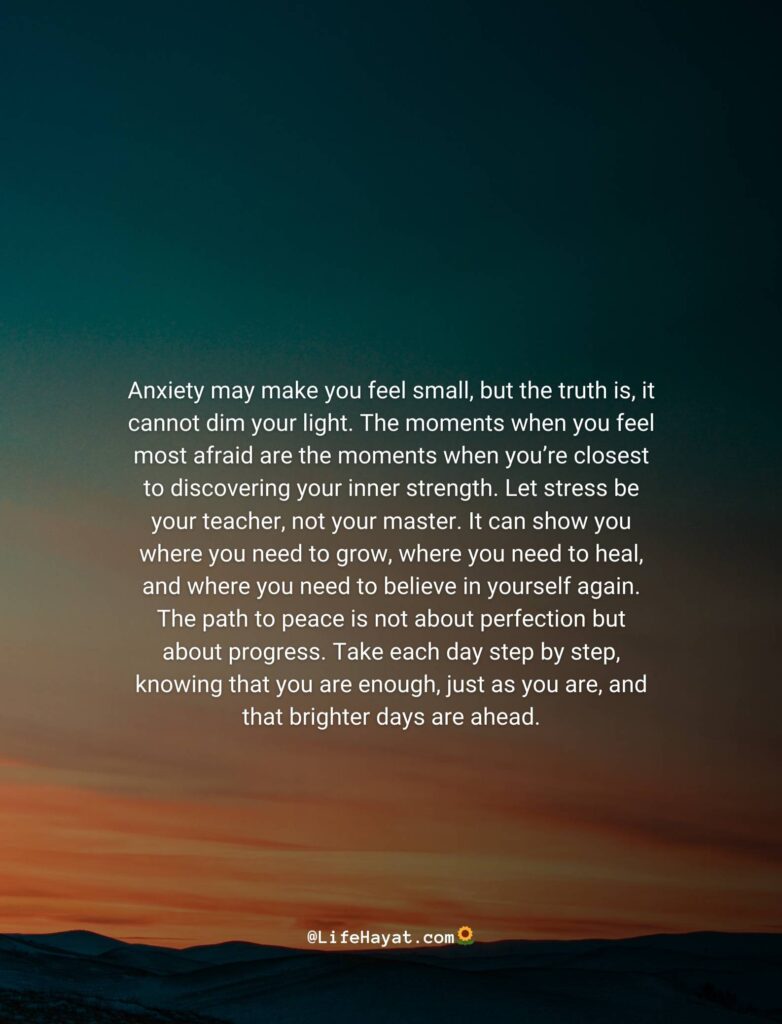
10. Practice Guided Visualization
Visualization creates a mental escape from stress and provides clarity in overwhelming situations. If you’re wondering how to overcome anxiety daily, guided visualization helps you build mental resilience and find peace even in chaotic moments. By practicing this technique regularly, you’ll learn to redirect your focus and regain control over your thoughts.
Why it works: Visualization helps create a mental “safe space,” reducing stress and promoting relaxation.
How to do it:
- Close your eyes and imagine yourself in a peaceful environment, like a beach or forest.
- Engage your senses—feel the warmth of the sun, hear the waves, or smell fresh pine.
- Spend 5-10 minutes focusing on this scene, pairing it with deep breathing.
Motivational Effect: Visualization reminds you that calmness is always within your reach, no matter the chaos around you.
50 Positive Affirmations For The Day
Conclusion
How to Overcome Anxiety Daily is about creating a routine that supports your mental and physical health. By incorporating these simple yet powerful practices into your life, you’ll build resilience, find balance, and regain a sense of control.
Call-to-Action: Which practice will you start today? Share your journey in the comments below!


Morning Walks Sunshine Increasing
Serotonin and Endorphins to Improve
Positive Mood Indeed a Practice Of
Regulating Calmly Breathing to
Engage the Parasympathetic
Nervous System to Buffer
What the More Aroused
Sympathetic Nervous
System my Bring in
Anxious Feeling in Life
True Muscle Relaxation
As Our Feelings Senses in
Synergy of Neurohormonal
And Biochemical Properties Do
Flow Emotions From Toes to Head
With Yes Consistent Balanced Meals
Providing the Energy We Need For Focus
And Attention Span too With of Course Exercise
Regularly As All Of Nature is Evolved to Move one
of the Worst Activities in Ergonomic Injury is Sitting
Behind a Screen Motionless Dear Chaymaa Shown
By Science as Harmful as Smoking a Pack of Cigarettes
Each Day in Bringing Poorer Well Being to Us as We Spend our
Days
By Day
Getting in Touch With Our
Bodies For me at Least
A Moving Meditating Free
Flowing Balancing Dance Actually
Works in Synergy Of Providing So many
Positive Effects of Regulating Emotions Integrating
Senses Thereby Improving Cognitive Executive Functioning
in Focus Attention Span Short Term Working Memory and Long
Term Memory Retrieval
As Well As Journaling
And Particularly Free Poetry
Providing Connections of Our Emotions
With Words Allowing Better Regulation
of Emotions and Integration of Senses too…
Ah Yes at Best A Walk Outdoors With all the Benefits
of Sunlight Exposure in Moderation True even sitting
By a Window
Better than
Being in
A Closed in Cave
True Good Posture
In Non-Verbal Communication
Both Within and With Others
Increases Self Esteem With
Higher Levels of Serotonin too
One may even Make an Art of
it With ‘Power Poses too’ Yes it
Surely Works as Science Shows too
And It’s True even imagining exercising
As Science Shows in a Cast Will actually
Increase Muscle Size and Strength when
The Cast is Taken off Versus a Control Group
Of Those
Who Didn’t
imagine Exercise
That Way Ah Yes
Visualization Will
Practically Bring Mind
Over Matter ThiS WaY With SMiLes
All Great Points of Advice to Improve
Well Being and Reduce Anxiety Yet Perhaps
One of the Best Ways is simply Connecting to
Other Human Beings Warmly As that Increases
the Social Bonding Neurohormone Oxytocin that
Is a Naturally
Pain Killer
And
Anxiety
Reducing
Neurohormone too
And Acts of Service to
Others Without Expect
of Return is Shown to Increase
Well Being For Months thereby
Naturally Reducing Anxiety too
A Purpose Driven Life Moving Connecting
And Co-Creating With Others Will Produce
A Sweeter
Life Indeed
With SMiLes
Dear Chayma..:)
Thanks for reading the article thoroughly, you summarized it beautifully! 😊
Wishing you a happy day over there 🌻
Thanks for The
Article Dear Chaymaa
Wishing You A Great
Day in Cairo too☺️
Thanks 😊
☺️